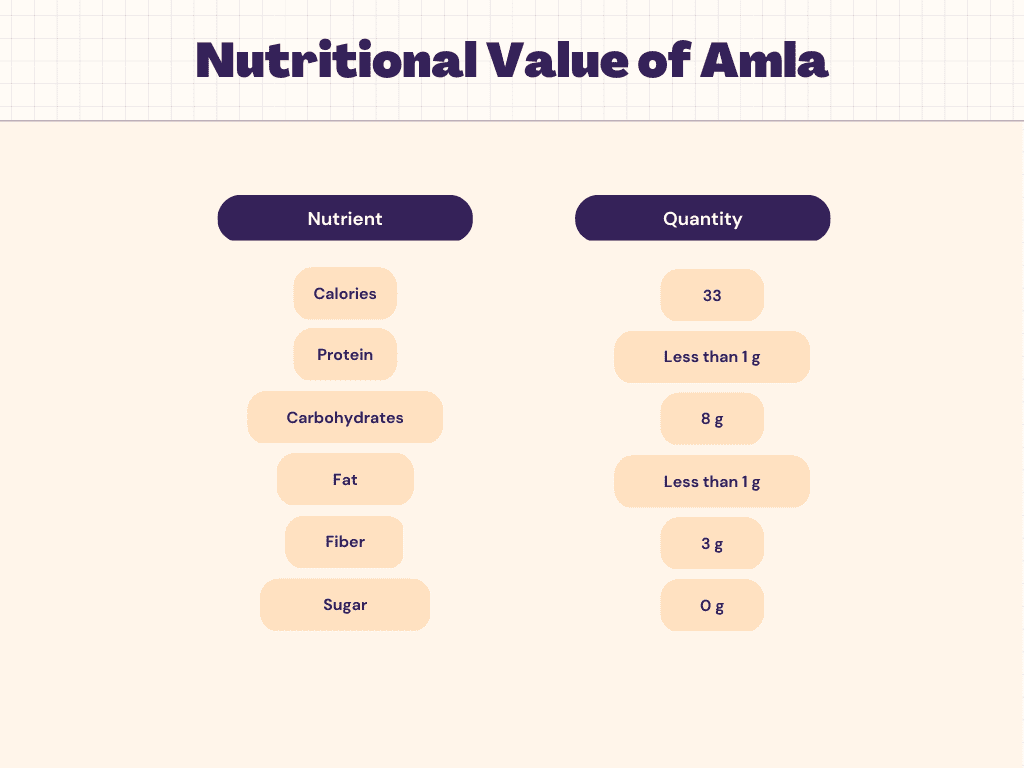Amla, a fruit that is grown in India and other adjacent nations, has acquired popularity as a “superfruit” around the globe. It should come as no surprise that 100 grams of fresh amla berries have the same amount of vitamin C as 20 oranges.
Amla, commonly referred to as Indian gooseberries, is a fruit that grows on the same-named flowering tree. The tiny berries are spherical, vivid, or yellow-green in color.
Nutritional Value of Amla
Nutritional Facts of Amla
Carbs
Amla also has extremely little fat and carbs in it. 150 g of amla, or one serving, has 66 calories, 1 gram of protein, 1 g of fat, and 15 g of carbs.
Fat
150 g of Amla has 1 g of fat, and 15 g of carbs. A glass of amla juice before a meal, according to regular customers, fills them up and causes them to eat less. Amla, according to nutritionists, increases metabolism and speeds up weight loss.
Protein
Contains 1 gram of protein
Health Benefits Of Amla
- Helps with Diabetes – Amla berries contain soluble fiber that dissolves quickly in the body, which slows down how quickly your body absorbs sugar. This may lessen blood sugar peaks. Amla berries are also beneficial for type 2 diabetics’ blood glucose and cholesterol levels. Check our Diabetes Plans.
- Helps with eye health – Vitamin A, which is essential to enhancing eye health, is abundant in amla berries.
- Increases immunity – More than double the adult daily recommended dose of 300mg of vitamin C is found in one 100g serving of amla berries, or roughly a half cup. Amla contains anti-inflammatory and antibacterial effects.
- Helps with brain health – Amla contains antioxidants and phytonutrients that can protect brain cells from free radical damage and attack, improving memory. Because of the high amount of Vitamin C in amla, your body can manufacture norepinephrine, a neurotransmitter that may help people with dementia work more clearly.
- Good digestion – Amla berries’ fiber aids in the body’s regulation of bowel motions and may help with the symptoms of illnesses like irritable bowel syndrome.
Vitamins & Minerals in Amla
Antioxidants found in abundance in amla berries lower the chance of developing chronic diseases like cancer, diabetes, and heart disease. In addition, amla berries are a great source of Vitamin C, E, A, Iron and Calcium
The Bottom Line
It has about 17 times the antioxidant strength of a pomegranate, twice the antioxidant power of an acai berry, and eight times the vitamin C of an orange. The common name for the lowly Indian gooseberry, Amla, is entirely appropriate. The transparent green fruit, whose name is derived from the Sanskrit term “amlaki,” which means “nectar of life,” can shield us from a wide range of illnesses, including the common cold, cancer, and infertility.
FAQs
How many Amlas can I eat in a day?
Usually, it is advised to consume 1-2 amla each day, but you can also take it to suit your taste. It can be consumed either raw or as juice.
Should I eat an Amla before or after exercise?
Amla juice consumption has been demonstrated to improve gastrointestinal health, boost immunity, and support the respiratory system over time. Amla juice should be consumed as soon as possible after engaging in physical activity because the body starts to recuperate and restore itself at that point.
What are the benefits of Amla?
- Helps with Diabetes
- Helps with eye health
- Increases immunity
- Helps with brain health
- Good digestion
What is the best time to eat an Amla?
Amla is best consumed in the morning, especially during the chilly winter months. It also eliminates extra toxins from the body and is a fantastic natural source of calcium and Vitamin C. Amla is well renowned for its ability to treat numerous skin issues, including dandruff.









